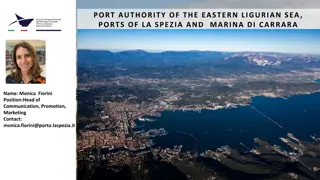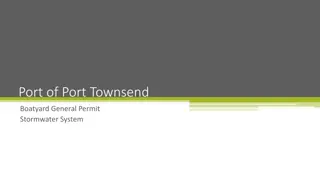Assessing Readiness for Port Community System Development and Implementation
Evaluation of readiness for developing and implementing a Port Community System (PCS) solution presented by Jonas Mendes Constante, a PCS expert from Trinidad & Tobago in November 2018. The overview includes the methodology for assessing readiness, lessons learned, phases of port digital transformation, and the vision of PCS as a system for coordinating cargo handling and shipping operations among port community members.
Download Presentation

Please find below an Image/Link to download the presentation.
The content on the website is provided AS IS for your information and personal use only. It may not be sold, licensed, or shared on other websites without obtaining consent from the author.If you encounter any issues during the download, it is possible that the publisher has removed the file from their server.
You are allowed to download the files provided on this website for personal or commercial use, subject to the condition that they are used lawfully. All files are the property of their respective owners.
The content on the website is provided AS IS for your information and personal use only. It may not be sold, licensed, or shared on other websites without obtaining consent from the author.
E N D
Presentation Transcript
Assessment of the readiness for the development and implementation of a Port Community System solution Jonas Mendes Constante PCS expert Trinidad & Tobago 14TH November, 2018
Overview Port Digital Transformation Methodology to assess the readiness for the development of a PCS solution Lessons learned 2
The four phases of the port digital transformation 4th Phase: A Port Community worldwide communicated Target: To increase effectiveness by means of operations automation in a paperless procedures. To modernize logistic management To increase communication by means of a total integration with external agents. To boost integration connecting Maritime - Port - Landside operations and improving collaboration within Port Community Strengthen ties with partner ports. 3rd Phase: Port Community 2nd Phase: Communicated Port Target: Creating communities, both at landside (with inland carriers) & at seaside (sea carriers) Port Community System Target: To set connections with port agents for key trading procedures and implementing Single Windows Cargo Manifest Customs Declarations Vessel call request & authorization Dangerous Goods Infostructure Services 1st Phase: Isolated Port Target: To automate internal procedures Internal Information Systems
The PCS Vision A PCS is a system that can be viewed as a virtualtable formed by the port community members to maintain coordination through accurate information of cargo handling and shipping operations 4
Overview Port Digital Transformation Assessing the readiness for implementing a PCS solution Lessons learned 5
Methodology - Phases 1. Analysis of International Case Studies 2. Country Missions Workshops with logistics and port sector stakeholders (public and private). Face-to-face interviews with key supply chain participants. 3. Analysis of the current situation 4. Proposition of PCS business and operating model 6
Phase 1 - International case studies 1. ValenciaportPCS.net (Valencia) 2. APCS (Antwerp) 3. Portbase (Rotterdam and Amsterdam) 4. PORTIC (Barcelona) 5. PortNet (Singapore) 6. AP+/Soget (Marseilles) 7. Dakosy (Hamburg) 8. Destin8 (Felixstowe) 9. Crimson Logic (Indian NPCS) 7
Phase 2 Country Mission - Workshop The objective of this activity is to understand the current situation and identify common views of the port community regarding topics that are directly related to a PCS implementation. Current Position - IT penetration, Visibility, Processes Value Proposition (PCS services) PCS possible benefits PCS governance options PCS Funding and pricing 8
Phase 2 Country Mission - Meetings Face-to-face interviews with: Government Port Authority Shipping agents Freight Forwarders Truck Drivers Shippers Logistics Operators Public agencies 9
Phase 4 - Proposition of the PCS model Guidance on the financing model 12
Phase 4 - Proposition of the PCS model RACI Matrix - Container Services Systems Stakeholders Freight Forwarders Shipping Lines & Custom System Carrier Systems Container Parks / Cargo owners Container Park Port Operating Road Hauliers Port Operator LSP Systems Customs & Inmigration NVOCCs Systems System PCS Services Container tracking O R R R R A I A A A I Sea Booking Validation O A I Delivery order (Gate in or admission) O I R A I I Pick-up orders (Gate out or release) O I R A I I Gate in/out reports O R I I A A Pre-receival advices (PRA) O A A I Empty container pick up advice O A A A Vehicle Booking System (VBS) O C A I I Port traffic management O I A Booking Reconciliation / Gate out reporting O A A A Electronic Import Delivery Orders (EIDO) O A A A Empty container return advice O A A A Information for Customs Reporting O C I I A Loading / discharge orders O I R R A A A Loading / discharge reports O R R A A Loading / discharge discrepancy lists O A A I Container Event Information O C A A A A A 13
Overview Port Digital Transformation Assessing the readiness for implementing a PCS solution Lessons learned from previews assessments 14
Lessons learned from previews assessments 1. Significant inefficiencies found mainly due to fragmented and inadequate cross-party information sharing and variable IT penetration. 2. Excessive number of information flows that are still based on email, phone or even personal contact. 3. Most port communities in the region are at a tippingpoint where a PCS may be possible and most of the stakeholders agree that it would be beneficial. 15
Lessons learned from previews assessments 4. community participation since day 1 may lead to an unnecessary waiting. It is important the involvement of all port stakeholders but expect full 5. Port Authorities have demonstrated interest in leading the initiative. 6. Great opportunity to implement a PCS solution based on blockchain technology. 16
Thank you! Jonas Mendes Constante PCS expert jonasmendes@gmail.com Trinidad & Tobago 14TH November, 2018























